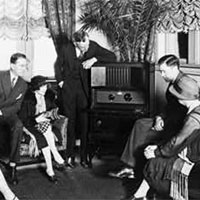 |

人們聚在一起聽廣播 (1920年代與1930年代)

|
 |
|
 |
哈丁總統在白宮裝設無線電:1922年2月8日
從1920年代開始,人們就習慣聚在收音機前聽廣播節目或新聞,就像我們現在坐在電視前面一樣。因為受到大眾歡迎,收音機成為政壇有力的溝通工具。在1933年成為美國總統的法蘭克林‧得雷諾‧羅斯福 (Franklin
Delano Roosevelt) 就定期透過廣播向美國大眾報告國情。在第一次演說中,羅斯福向大眾解釋因應經濟大蕭條的國家政策:「我的朋友們,我想要告訴你們政府最近幾天所做的事情,為什麼我們要採取這些行動,以及接下來要採取哪些步驟等等。」這些談話就是華盛頓CBS電台經理哈利‧布契爾 (Harry
Butcher) 所說的「爐邊談話」 (fireside
chat) 。
到了現在,雖然總統還是會透過廣播發表演說,但是人們已經習慣看電視轉播,而不是在收音機旁聽廣播了。西元1939年,羅斯福成為第一位在電視上發表演說的美國總統。無線電廣播的「黃金時代」在電視的「黃金時代」來臨時,顯然已經開始褪色了。
Starting in the 1920s, people gathered around the radio to listen to programs or the news, much like we gather around the TV. With its new popularity, radio became a powerful communication tool in politics. Franklin Delano Roosevelt, who became president in 1933, used the radio to deliver regular updates to the American public. In his first address, he explained his plan for fighting the Great Depression, "My friends, I want to tell you what has been done in the last few days, why it has been done, and what the next steps are going to be." The talks became known as "fireside chats," named by Harry Butcher, a CBS station manager in Washington.Today, although we still have radio addresses by the president, more people see the president speak on television than listen to him on the radio. In 1939, Roosevelt was the first U.S. president to deliver a televised speech. The "golden age" of radio was about to fade as television entered its "golden age."

 3/3 頁
3/3 頁
|





